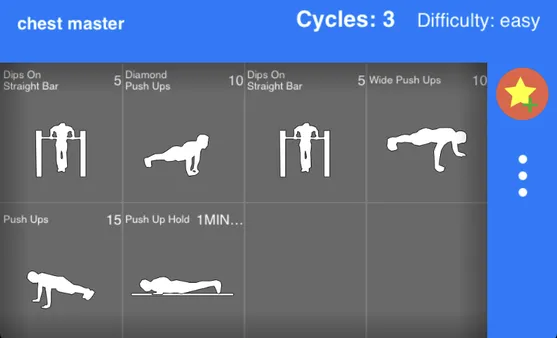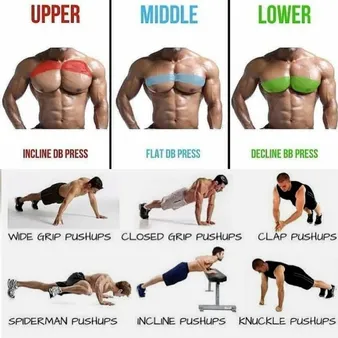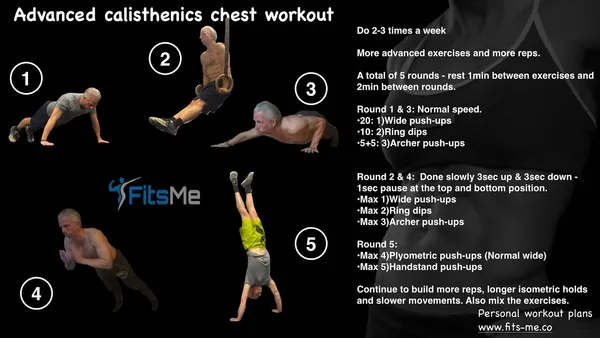Table of Contents
calisthenics for chest is a great way to build strength and muscle definition in your chest without having to use weights. It is a bodyweight training method that uses exercises like push-ups, dips, and flyes to target the chest muscles. Calisthenics for chest can be done anywhere, making it a convenient and effective way to get a great workout. If you are looking to build a stronger, more defined chest, then calisthenics is a great option. Kizworld has a variety of calisthenics for chest exercises that can help you get started.
Calisthenics for Chest: Build a Powerful Chest Without Weights
I. Benefits of Calisthenics for Chest Development
Improved Muscle Mass and Strength
Calisthenics exercises for the chest, such as push-ups and dips, effectively target and engage the chest muscles, leading to increased muscle mass and strength. These exercises challenge the chest muscles through a full range of motion, promoting muscle growth and definition.
Enhanced Functional Fitness
Calisthenics for chest development not only builds muscle but also improves functional fitness. Exercises like push-ups and dips require coordination, balance, and core stability, enhancing overall athleticism and daily movement efficiency.
Increased Calorie Expenditure
Calisthenics exercises for the chest are compound movements that involve multiple muscle groups simultaneously. This high level of muscle activation results in increased calorie expenditure, contributing to weight management and fat loss.
Exercise | Benefits |
|---|---|
Push-ups | Builds chest mass, improves shoulder stability |
Dips | Targets triceps and chest, enhances upper body strength |
Improved Posture and Flexibility
Calisthenics exercises for the chest promote proper posture by strengthening the muscles that support the spine. Additionally, these exercises can improve flexibility in the chest and shoulder muscles, reducing the risk of muscle imbalances and injuries.Discover the Comprehensive Benefits of Calisthenics for Bodyweight Training
Reduced Risk of Injuries
Calisthenics exercises for the chest are low-impact and bodyweight-based, minimizing the risk of injuries compared to traditional weightlifting exercises. This makes calisthenics a suitable option for individuals of all fitness levels, including beginners and those recovering from injuries.Avoid Common Calisthenics Mistakes: A Guide to Proper Technique
Convenience and Accessibility
Calisthenics exercises for the chest can be performed anywhere, anytime, without the need for expensive equipment or gym memberships. This convenience and accessibility make it easy to incorporate chest development into your fitness routine, regardless of your schedule or location.
Benefits of Calisthenics for Chest Development
II. Effective Calisthenics Exercises for Chest
Push-Ups
Push-ups are a classic calisthenics exercise that targets the chest, triceps, and shoulders. They can be done anywhere, making them a great option for people who don't have access to a gym. To do a push-up, start by placing your hands on the floor shoulder-width apart, with your feet together. Lower your body until your chest is almost touching the floor, then push back up to the starting position. You can make push-ups more challenging by elevating your feet on a bench or chair.How to Do a Push-Up
Dips
Dips are another great calisthenics exercise for the chest. They can be done on a dip bar or on two parallel surfaces, such as two chairs. To do a dip, start by placing your hands on the bars or surfaces shoulder-width apart. Lower your body until your chest is almost touching the bars or surfaces, then push back up to the starting position. You can make dips more challenging by adding weight to your body.How to Do a Dip
Pike Push-Ups
Pike push-ups are a more advanced calisthenics exercise that targets the chest, shoulders, and triceps. To do a pike push-up, start by placing your hands on the floor shoulder-width apart, with your feet together. Walk your feet back until your body forms an inverted V-shape. Lower your body until your head is almost touching the floor, then push back up to the starting position. You can make pike push-ups more challenging by elevating your feet on a bench or chair.How to Do a Pike Push-Up
Exercise | Difficulty | Equipment |
|---|---|---|
Push-Ups | Beginner | None |
Dips | Intermediate | Dip bar or two parallel surfaces |
Pike Push-Ups | Advanced | None |
Handstand Push-Ups
Handstand push-ups are the most challenging calisthenics exercise for the chest. They require a lot of strength and balance. To do a handstand push-up, start by placing your hands on the floor shoulder-width apart, with your feet together. Kick your legs up into a handstand, then lower your body until your head is almost touching the floor. Push back up to the starting position. You can make handstand push-ups more challenging by adding weight to your body.How to Do a Handstand Push-UpThese are just a few of the many calisthenics exercises that you can do to build a strong chest. If you're new to calisthenics, start with the beginner exercises and gradually work your way up to the more advanced exercises. With consistent practice, you'll be able to build a chest that you're proud of.
Effective Calisthenics Exercises for Chest
III. Tips for Maximizing Chest Gains through Calisthenics
Progressive Overload
Push your body harder over time to continue stimulating muscle growth. Gradually increase the number of repetitions, sets, or the difficulty of the exercises.
Related Post: How to Build Muscle and Strength with Calisthenics
Compound Exercises
Focus on exercises that work multiple muscle groups simultaneously, such as push-ups, dips, and plyometrics. These compound exercises are more efficient and effective for building overall chest strength and mass.
Related Post: The Best Calisthenics Exercises and Variations
Proper Form
Maintain proper form throughout your exercises to maximize their effectiveness and prevent injuries. Engage your chest muscles actively, keep your shoulders down and back, and extend your elbows fully during each movement.
Variations and Modifications
Incorporate variations and modifications of exercises to target different areas of the chest and challenge your muscles in new ways. For example, try incline push-ups to emphasize the upper chest or decline push-ups to focus on the lower chest.
Exercise | Muscles Worked | Difficulty |
|---|---|---|
Push-ups | Chest, triceps, shoulders | Beginner |
Incline Push-ups | Upper chest | Intermediate |
Decline Push-ups | Lower chest | Advanced |
Frequency and Volume
Train your chest muscles regularly, aiming for at least two to three times per week. Adjust the volume of your workouts, which refers to the number of sets and repetitions, based on your fitness level and recovery capacity.
Rest and Recovery
Allow adequate time for rest and recovery between workouts to facilitate muscle repair and growth. Get sufficient sleep, hydrate well, and consider incorporating active recovery activities like yoga or swimming to promote blood flow and muscle relaxation.
Related Post: Improve Your Flexibility with Calisthenics
Tips for Maximizing Chest Gains through Calisthenics
IV. Nutrition and Recovery for Calisthenics Chest Development
Proper nutrition and recovery are essential for maximizing chest gains through calisthenics. Here are some key considerations:
Protein: Protein is essential for muscle growth and repair. Aim for 1.6-2.2 grams of protein per kilogram of body weight per day. Good protein sources include lean meats, poultry, fish, beans, lentils, and tofu.
Carbohydrates: Carbohydrates provide energy for your workouts. Choose complex carbs like brown rice, quinoa, oatmeal, and whole-wheat bread over simple carbs like white bread and sugary drinks.
Fats: Healthy fats support hormone production and cell function. Include healthy fats in your diet from sources like avocados, nuts, seeds, and olive oil.
Hydration: Staying hydrated is crucial for overall health and performance. Drink plenty of water throughout the day, especially before, during, and after workouts.
Rest: Adequate rest is essential for muscle recovery. Aim for 7-9 hours of sleep per night. During sleep, your body releases hormones that promote muscle growth.
Supplements: Some supplements can support calisthenics chest development, such as creatine, beta-alanine, and BCAAs. However, it's important to consult with a healthcare professional before taking any supplements.
Nutrient | Recommended Intake | Sources |
|---|---|---|
Protein | 1.6-2.2 grams per kilogram of body weight per day | Lean meats, poultry, fish, beans, lentils, tofu |
Carbohydrates | 4-6 grams per kilogram of body weight per day | Brown rice, quinoa, oatmeal, whole-wheat bread |
Fats | 20-35% of daily calories | Avocados, nuts, seeds, olive oil |
By following these nutrition and recovery tips, you can optimize your calisthenics chest development and achieve your fitness goals.
Related Posts:
- The Best Calisthenics Supplements and Nutrition
- How to Train Like a Calisthenics Pro
- The Most Common Calisthenics Mistakes and How to Fix Them
Nutrition and Recovery for Calisthenics Chest Development
V. Conclusion
Calisthenics for chest is a great way to build strength, muscle, and definition in your chest. It is a versatile and accessible form of exercise that can be done anywhere, anytime. With a little creativity, you can create a challenging and effective calisthenics workout that will help you reach your fitness goals. So what are you waiting for? Get started with calisthenics for chest today and see the amazing results for yourself!